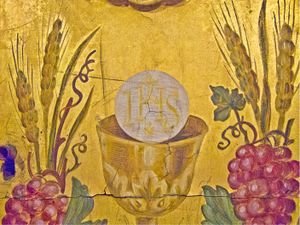Holy Thursday

The rubrics for the Sacred Mysteries create a set a standards by which a celebrant's performance may be evaluated. The bottom end of the performance scale is labeled, "As confused as a Jesuit in Holy Week."
Norms for Adoration of the Blessed Sacrament
- 49. For the reservation of the Blessed Sacrament, a place should be prepared and adorned in such a way as to be conducive to prayer and meditation; seriousness appropriate to the liturgy of these days is enjoined so that all abuses are avoided or suppressed.[3]
- When the tabernacle is located in a chapel separated from the central part of the church, it is appropriate to prepare the place of repose and adoration there.
- 49. For the reservation of the Blessed Sacrament, a place should be prepared and adorned in such a way as to be conducive to prayer and meditation; seriousness appropriate to the liturgy of these days is enjoined so that all abuses are avoided or suppressed.[3]
- 51. The washing of the feet of chosen men which, according to tradition, is performed on this day, represents the service and charity of Christ, who came "not to be served, but to serve."[4] This tradition should be maintained, and its proper significance explained.
- 55. The Blessed Sacrament should be reserved in a closed tabernacle or pyx. Under no circumstances may it be exposed in a monstrance.[5]
- The place where the tabernacle or pyx is situated must not be made to resemble a tomb, and the expression "tomb" is to be avoided. The chapel of repose is not prepared so as to represent the "Lord's burial" but for the custody of the Eucharistic bread that will be distributed in Communion on Good Friday.
- 56. After the Mass of the Lord's Supper the faithful should be encouraged to spend a suitable period of time during the night in the church in adoration before the Blessed Sacrament which has been solemnly reserved. Where appropriate, this prolonged eucharistic adoration may be accompanied by the reading of some part of the Gospel of St. John (chs. 13-17).
- 57. After Mass the altar should be stripped. It is fitting that any crosses in the church be covered with a red or purple veil, unless they have already been veiled on the Saturday before the Fifth Sunday of Lent. Lamps should not be lit before the images of saints.
Commentary
- Fr. Edward McNamara, "More on Holy Thursday."
- Emphasis added. MXM, SJ
- There is absolutely no contradiction here because Eucharistic adoration is not synonymous with exposition in the monstrance. Christ is equally adored in the tabernacle and the pyx as in the monstrance. Adoration in the monstrance helps the adorers concentrate on the Eucharistic mystery but does not make the adoration essentially different from worship offered to Our Lord in the tabernacle.
- Also, adoration in the monstrance usually unfolds into the joyous experience of Eucharistic Benediction, whereas in the concrete case of Holy Thursday the essential theme is accompanying him during his agony, and there is no Benediction.
- The rule forbidding solemn adoration after midnight means that there should be no further public prayers at the altar of repose once Good Friday begins. This does not prohibit private prayer and private adoration at the altar of repose; these may continue until the beginning of the celebration of the Passion on Good Friday.
A Plea for Peace
Please do not browbeat your pastor with arguments about liturgical norms during Holy Week. The time for a calm, thoughtful discussion of what must, can, or should be done in a particular parish church is some time after Easter. In my view, "unsolicited advice is criticism." Our Lord says that we should calculate the odds of winning a battle before going to war (Lk 14:31-32). The likelihood of changing your pastor's mind during Holy Week is vanishingly small. If your church does not or cannot provide a chapel for adoration after midnight on Holy Thursday, you may, perhaps, be able to find some other nearby church that does.
References
- ↑ Cf. "Roman Missal," Evening Mass of the Lord's Supper, n. 1.
- ↑ Second Vatican Council, Constitution on the Sacred Liturgy "Sacrosanctum Concilium," n. 55; SRC, Instr. "Eucharisticum Mysterium" (May 25, 1967), n. 31. AAS 59 (1967), pp. 557-558.
- ↑ SCR, Decree "Maxima Redemptionis Nostrae Mysteria" (November 16, 1955), n. 9, AAS 47 (1955), p. 895.
- ↑ Mt 20:28.
- ↑ Emphasis added. MXM, SJ>
- ↑ Emphasis added. MXM, SJ>
- ↑ Cf. "Roman Missal," Evening Mass of the Lord's Supper, n. 21; SCR, Decree "Maxima Redemptionis Nostrae Mysteria" (November 16, 1955), nn. 8-10 AAS 47 (1955), p. 845.
Links
- "Paschalis Solemnitatis: The Preparation And Celebration Of The Easter Feasts," circular letter from the Congregation for Divine Worship, January 16, 1988.
- "I Was Wrong about Good Friday."
- "Eucharist in Sacristy Safe."
- "More on Holy Thursday."